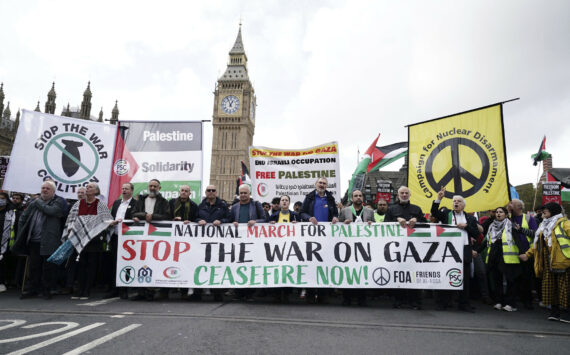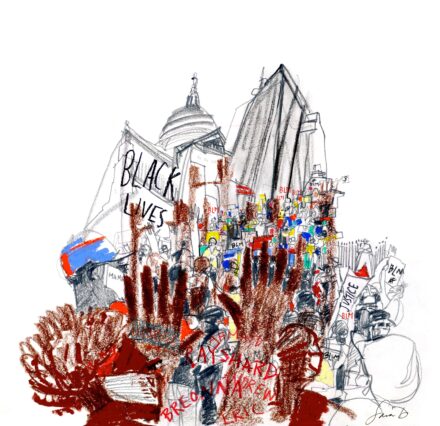
How to prepare for a protest
A couple of younger first-time protestors asked me for some tips on what to think about and how to prepare, so I gathered a few notes. I hope these are helpful!
Most protests are peaceful and inspiring events, attended by diverse people who all share the same values, hopes and the same care for a cause. The vast majority of people understand that the purpose of a protest is to call attention to an issue and the best way to do that and get more people on board is through peaceful protest. This has been proven time and time again throughout history. The most successful protests are peaceful, happy events and have a clear message of what action is wanted and are sometimes combined with boycotting, diversification and demands for sanctions. (BDS)
Some useful tips!
1. Check the Weather. Be prepared for the anticipated weather – apply sunscreen or tuck in some plastic bags to keep your cell phone and wallet dry. You can get a cheap rain poncho at a local sports store.
2. Make Signs. These don’t have to be super-elaborate; permanent marker on poster board is works great. (Permanent marker is a good idea in case of rain.) Be concise and legible and avoid profanity as that can provoke police to take the sign from you. PRO TIP: Make extra signs to hand out to fellow protesters that did not bring their own. A creative sign can travel much further via social media than a nasty one!
3. Personal Care. Protesting is thirsty work! Bring water. Drink a lot of water beforehand and take a couple of bottles of water with you to keep your energy up. Just in case, scope out the availability of portable toilets. Ladies might want to bring extra precautions in case of emergencies. Do not forget medications and emergency meds. Keep them in a bag clearly labelled. Add the letters ICE to the emergency contacts In your phone. Make it easy for any medical teams to find info on your conditions if you are unable to speak.
4. Make a Plan with your Posse. Cell service is often spotty in large groups of people, so make a plan in advance with the people you’re going with – discuss where to meet and at what time in case you get separated. Make sure that you tell the plan to someone who isn’t going so they can follow up to make sure everyone is safe and accounted for after the event. PRO TIP: Find a way to visually spot people in your group with relative ease – have each person wear a bright yellow glove they an raise in the air if separated or the same hat/ flags/ signs/mascots. Bring extra phone batteries/ chargers. If you don’t have anyone to go with see if you can see if you can find a local group who is attending, or ask if anyone would like to share transport and march with you!
5. Plan your transportation ahead of time. Make sure you are careful going to and from the demonstration. See if you can travel with someone else. Parking close to the event will probably be limited, and public transportation will likely be rerouted if it’s a large gathering. So, finalize your details ahead of time. Explore whether shuttle buses are being arranged from outlying parking lots, or arrange for a rideshare car service to pick you up at a specific spot. Joining a group bus is always a good option.
6. Wear Face Masks. Wearing a mask prevents the spread of viruses but doubles up as a privacy shield. Bring hand sanitiser. Protect yourself and others by reducing the risk of spreading airborne illnesses, such as as the coronavirus, by covering your nose and mouth with a face mask and using hand sanitiser regularly. High risk people may also consider goggles and sunglasses for eye protection.
7. Decide who your emergency contact is. Write it on your body in permanent marker, add it to your mobile. Add phone numbers to kids clothes. You’ll probably never need it, but it’s good to take the precaution in case you have a medical emergency or are detained and your cell phone is taken away. If you’re bringing kids, it’s a good idea to write your cell number and the number of someone not at the protest on their arms and in their clothing just in case you get separated.
8. Charge your cell phone and carry a spare battery. Cell service may be limited, but you may want to film the event or take pictures of clever signs. Be sure to ask permission before you take a picture of someone and always blur faces out before you share pictures.
9. Wear comfy shoes and clothes. Every protest or rally means a lot of standing! Dress in layers in case the weather changes. Don’t carry more than necesary.
10. Share your experience. One of the best things about activism is that it reminds you that you are not alone. Use the common hashtag of the event/cause and share your photos, video and stories on social media; this has the added bonus of increasing the reach of the protest and encouraging others to get involved. Remember to blur out people’s faces when posting.
11. Take your kids. It’s never too young for kids to see their parents get involved about a cause they’re passionate about. If safe and appropriate, include your kids in the protest plans. Just remember that most rallies and protests aren’t geared toward disabled people or children, so it is best to bring strollers, snacks, water and even something for them to do for the littlest activists.
12. Keep it Peaceful. The point of pretesting is to have your voice heard without inciting violence. It is well within your rights to be loud. If a policeman asks you why you are there, you can be friendly and charming and just say “To protest peacefully.” There is NO legal requirement to engage in negotiation with the police about any form of protest, but some police see it as antagonizing to not reply. There is also no legal requirement to notify police about other forms of protest which do not involve a march, but instead remain ‘static’. Organisers of rallies, public meetings (indoors or outdoors), and other forms of protest which stay in one place, do not have to talk to the police at all. (UK) If in doubt stand still and move to the sidelines. Taking part in protests is NOT unlawful simply because the organisers did not talk to police. If you decide not to talk to the police, make sure you have legal observers present.
13. Videoing. As a general rule, you do have a right to pull out your cell phone camera—especially if you ask nicely—and videotape police so long as you are doing it openly. Police do *not* have a right to take or delete the pictures or videos on your cell phone. You can’t break any other laws in the context of filming an officer (like trespassing on private property), and you certainly can’t obstruct police activity while filming a police officer.
14. Know the Law. It is recommended to google your rights in your country before attending a protest. Always be polite and calm even when asserting your rights.
Links
https://www.aclunc.org/our-work/know-your-rights/know-your-rights-free-speech-protests-demonstrations
https://www.amnesty.org.uk/protest-isahumanright
https://www.gov.uk/check-legal-aid
Sara Dilliplane’s sketch from a Black Lives Matter demonstration. (Courtesy)

